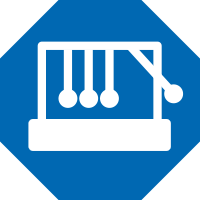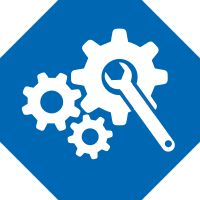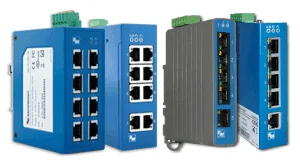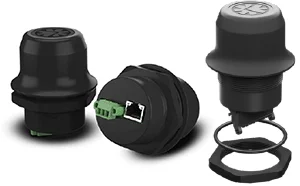
After the first considerations in 2000 by the members of the PROFIBUS user organization regarding a PROFIBUS successor, the first specification for PROcess-FIeld-NETwork(IO) was published in 2003, which is currently widely used. The idea was to combine the advantages of the proven PROFIBUS with the benefits of Industrial EtherNet. The flexibility of the variants and the modularity offer an optimum solution for most applications. PROFINET is standardized in the IEC61158 and IEC61784 standards.
Physics

The transmission technology specified is 100 Mbit/s EtherNet (IEEE802) as copper 100 BaseTX or 100 BaseFX in full-duplex operation. The cable length for 100 BaseTX may be a maximum of 100 m between the participants, or several kilometers if fiber optics are used, depending on the technology used.
Connections via WLAN and Bluetooth are possible with restrictions in real-time behavior.
RJ45 technology is usually used as the connection technology, but M8 or M12 screw connectors are also used.
Topology

The topologies specified by EtherNet are used. In the simplest case, a star topology with a switch as the central node. Star networks can be interconnected.
An integrated switch with two EtherNet ports is quite common with many PROFINET field device providers. The advantage here is that a classic line topology can be set up to reduce cabling costs.
Tree structures are also possible with these technologies.
In order to manage the topology easily and adapt it quickly, PROFINET offers the Link Layer Discovery Protocol (LLDP) to identify which device is located on which switch port. This is also the basis for simple device replacement via the PROFINET Engineering Tool.
The media redundancy protocol (MRP) allows a ring topology to be set up to increase reliability.
PROFINET is a provider-consumer system with three different device types:
- In most cases, the PROFINET Controller is a programmable logic controller (PLC) that executes the automation program (comparable to PROFIBUS Master Class 1).
- The PROFINET Supervisor can be the programming device (PC) or an operating device (HMI) (comparable to PROFIBUS Master Class 2).
- The PROFINET device is a decentralized field device that is monitored and controlled by an IO controller. An IO device can consist of several modules and submodules for inputs and outputs.
The supported number of participants in a network is theoretically 65 million. As PROFINET is multi-controller capable (also due to the EtherNet physics), the number of PROFINET devices on a controller depends on the performance of the controller. For example, a Siemens S7 1200 has up to 8 connections, while the S7 1500 series has 96 to 384 connections.
PROFINET IO-Realtime (Profinet IO-RT) enables the transmission of process data in the range of one to ten milliseconds and is therefore suitable for most applications. RT data is transmitted with priority over other data traffic.
The update rate can be configured individually for each PROFINET participant as required. The maximum deviation during transmission is one microsecond (jitter). As this high performance requires appropriate hardware support, all participants must be suitable for Profinet IO-IRT.
Up to 1440 bytes of process data can be transmitted per IO device.
The device is addressed via MAC or IP address using an address resolution via a symbolic, unique PROFINET device name, which is set via software.
Data is addressed by specifying the slot, sub-slot and index. This information is part of the respective device description file of a PROFINET participant. For modular devices, the slot and index can be seen in the visual bus configuration.
PROFINET supports cyclical data transmission (IO data) as well as parameter/demand data (record data) and corresponding diagnostics/alarms.
Device conformance classes make it possible to select field devices that support certain minimum properties in terms of functionality and performance.
Conformance Class A
Basic functionality for data exchange between device and controller cyclically, acyclically (at least identification and maintenance) and device diagnostics.
Conformance Class B
Addition of further functions such as simplified device replacement, access of several controllers to different functions of a device (e.g. inputs), network diagnostics via SNMP.
Optional: Redundancy functions (MRP), fast start-up (Fast Start-Up)
Conformance Class C
Hardware-supported bandwidth reservation (PROFINET IO-IRT),
Optional: Clock synchronization, redundancy without delay (MRPD, Media Redundancy for Planned Duplication)
Conformance Class D
Support for Time-Sensitive Networking (TSN)

PROFINET configuration is usually carried out using software provided by the PROFINET controller provider, usually a PLC. The device description files (GSD files) are integrated so that the configuration can be carried out using the device properties described there. The device name, modules selected, cycle times and behavior in the event of an error, etc. are set.
Variants / Versions

PROFINET Isochronus Realtime (PROFINET IO-IRT) is characterized by maximum determinism and clock synchronism in order to meet the requirements of Conformance Class C. Update rates of 250 microseconds and faster can be achieved. The maximum deviation during transmission is one microsecond (jitter). As this high performance requires corresponding hardware support, all participants must be designed for PROFINET IO-IRT.
With the help of application profiles, providers have agreed on the properties of their products for various applications, including profiles for drives (PROFIdrive), encoders, identification systems, railroad applications, energy management and functional safety (PROFIsafe).









